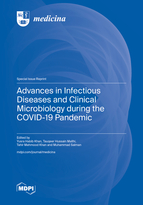Advances in Infectious Diseases and Clinical Microbiology during the COVID-19 Pandemic
A special issue of Medicina (ISSN 1648-9144). This special issue belongs to the section "Infectious Disease".
Deadline for manuscript submissions: closed (31 May 2023) | Viewed by 34066
Special Issue Editors
Interests: infectious diseases; vaccination; pharmaceutical care; clinical pharmacy; renal care; pharmacovigilance; pharmacoepidemiology; public health
Special Issues, Collections and Topics in MDPI journals
Interests: infectious diseases, dengue; Zika; influenza; Congo virus; vaccination; pharmaceutical care; clinical pharmacy; renal care; pharmacovigilance; pharmacoepidemiology; public health
Special Issues, Collections and Topics in MDPI journals
Interests: infectious diseases, dengue; Zika; influenza; Congo virus; vaccination; pharmaceutical care; clinical pharmacy; Rena care; pharmacovigilance; pharmacoepidemiology; public health
Interests: infectious diseases, dengue; zika; influenza; Congo virus; vaccination; pharmaceutical care; clinical pharmacy; Rena care; pharmacovigilance; pharmacoepidemiology; public health
Special Issue Information
Dear Colleagues,
Infectious diseases are significantly associated with morbidity and mortality, constituting one of the highest proportions of hospitalization. The COVID-19 pandemic has led to substantial changes in population behaviors toward infectious diseases. The change in the pattern of various infectious diseases has also been observed during the pandemic. Evidence suggests the same nonpharmaceutical interventions employed to prevent transmission of severe acute respiratory syndrome coronavirus 2 (SARS-CoV-2) likely led to reduced incidence of influenza in various regions across the globe. However, the COVID-19 pandemic has caused disruptions in the reporting of other infectious diseases such as sexually transmitted diseases and coronavirus infections. There are also other serious infections such as HIV/AIDS, tuberculosis, and hepatitis that carry equivalent health risks to the global population. Decreased reporting of notifiable infectious diseases and conditions during the COVID-19 pandemic remained a major concern for health authorities. Ascertaining the impact of the COVID-19 pandemic on transmission patterns of other infectious diseases holds significant implications for public health, but this topic has not yet been studied to a greater extent. Understanding the impact of the COVID-19 pandemic and related prevention and control measures on the incidence of other infectious diseases is of great significance. Moreover, the COVID-19 pandemic also resulted in improved healthcare metrics for other infectious diseases, i.e., improve influenza vaccination rate during the pandemic. On the other hand, the scope and relevance of clinical microbiology have been appreciated more than ever. The knowledge and the training about the viral structure, transmission, early diagnosis, and the best sterilization and disinfection process were the key elements that a clinical microbiologist shared for the betterment of the community throughout the pandemic. The COVID-19 pandemic has initiated new horizons for infectious disease research, control, funding acquisitions, administrative assistance, and health promotion. This issue emphasizes various aspects of the advancements in infectious diseases and clinical microbiology during the ongoing COVID-19 pandemic.
This Special Issue welcomes submissions ranging from Original, Clinical, and Translational articles and Reviews in the field of Clinical Microbiology and Infectious Diseases during the COVID-19 Pandemic.
Dr. Yusra Habib Khan
Dr. Tauqeer Hussain Mallhi
Dr. Tahir Mehmood Khan
Dr. Muhammad Salman
Guest Editors
Manuscript Submission Information
Manuscripts should be submitted online at www.mdpi.com by registering and logging in to this website. Once you are registered, click here to go to the submission form. Manuscripts can be submitted until the deadline. All submissions that pass pre-check are peer-reviewed. Accepted papers will be published continuously in the journal (as soon as accepted) and will be listed together on the special issue website. Research articles, review articles as well as short communications are invited. For planned papers, a title and short abstract (about 100 words) can be sent to the Editorial Office for announcement on this website.
Submitted manuscripts should not have been published previously, nor be under consideration for publication elsewhere (except conference proceedings papers). All manuscripts are thoroughly refereed through a single-blind peer-review process. A guide for authors and other relevant information for submission of manuscripts is available on the Instructions for Authors page. Medicina is an international peer-reviewed open access monthly journal published by MDPI.
Please visit the Instructions for Authors page before submitting a manuscript. The Article Processing Charge (APC) for publication in this open access journal is 1800 CHF (Swiss Francs). Submitted papers should be well formatted and use good English. Authors may use MDPI's English editing service prior to publication or during author revisions.
Keywords
- COVID-19
- infectious diseases
- clinical microbiology
- SARS-CoV-2
- epidemiology
- pandemic
- health policies
- vaccination
- communicable diseases










